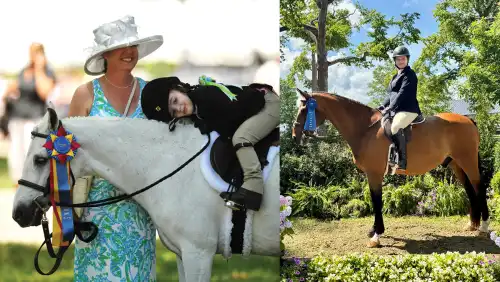High Performance hunter classes are to be judged using normal judging principles for hunters. Hunters will be rewarded for good jumping style, consistent pace and distances, beauty and good movement. Over the more difficult courses that these classes offer, particular attention should be paid to athletic ability, boldness and brilliance. The different types of jumps are designed to separate and promote great jumping style and bold accurate hunter riding.
In both rounds there will be FOUR HIGHER OPTION FENCES, offered and set at 4′ TO 4’3’’ in height. As of June 2, 2010, 1 point will be added for every high option jumped. Currently, we are asking the judges to use this system so that those horse and rider combinations that do take the risk will be rewarded.
There is some strategy required of the hunter riders to show their horses off to their best advantage. The plan for any rider is to have the best round possible over the track that is the easiest, and includes the lowest and simpler fences. However, if a rider has a very bold and athletic jumper, he might choose to risk taking a track that includes the higher and more difficult fences. If he is successful in negotiating this track, he will be rewarded. He will receive 1 point for every high option jump that is jumped.
The end result of each class may be very different. In some cases the cautious but successful round may prove to be the winner, while in other classes the rider who takes some bold, but successful risks may ultimately win the class. As judges of this class, it is your job to factor what options riders take, and reflect the high option points in the final scores. Again, riders who take more difficult options will be REWARDED!
There are 10 bonus points per panel of judges to be given for classic hunter style. The round is scored and then you ask yourself:
- How stylish was that horse?
- Did he move across the ground lightly and efficiently with athletic agility?
- Did the silhouette of the horse give you the impression of the classic hunter look?
- Did the horse jump in great hunter style?
Now on a 1-10 scale, score this horse on the overall presence and style as a hunter. You can break it down into an easy system.
- 3 points for how well the horse jumps
- 3 points for the movement
- 3 points for the overall look as a classic hunter
- 1 extra point if you feel the horse was spectacular in one of those areas
In the handy hunter round of these classes, there is a judging system in place to take care of judging the handy phase. As the judge, you are to watch the round and score it as you would normally, based on pace, style and jumping ability.
ADVERTISEMENT
In addition, you are required to give an additional score for how handy the rider was in his round. This score will be a number from 1-10 and will be added to the overall score of the horse and rider combination. If you feel a rider was very handy, did all the more difficult turns and option fences, and was very brilliant and successful at this, he might receive a score of 10 to be added to his overall score. If, on the other hand, you feel the rider was very cautious and careful, taking few difficult turns or options, you have the choice of adding no points at all, or perhaps 1, 2 or 3 points.
The rider that makes daring choices, takes harder options and successfully negotiates more difficult turns should be rewarded, and that reward must be reflected in this additional score for handiness.
The course designers are encouraged to use some imagination when building the route for the handy hunters.
Judges need to remember that riders must remain mounted if there is a gate to be opened. The amount of time and effort involved are to be considered when judging this as a part of a course. Problems such as backing up, making a circle, fretting, etc., are not to count as refusals, only as a lack of handiness. Once the gate is opened, the horse and rider should walk through and proceed promptly with the rest of the course. The gate will then be closed by ring crew. Make sure this has happened before the next horse is allowed on course. Another possible option for course designers is to place a log or small fence where riders are to dismount and lead the horse over the obstacle.
For safety reasons it is permissible for riders to unfasten martingales and raise or cross the stirrup irons. The pair should not be penalized for extra moments it may take to complete these tasks. When possible, judges are encouraged to consult with each other concerning the course before the class begins. It is always helpful for all to be on the same page.
This is a very new and exciting type of hunter class. As in all hunter competitions, beauty, good movement, great jumping style, and consistent and even pace are to be rewarded. What is different is that the difficulty of the courses and fences, coupled with the options available to the riders to be daring and brilliant. In any round boldness and brilliance should be rewarded.














